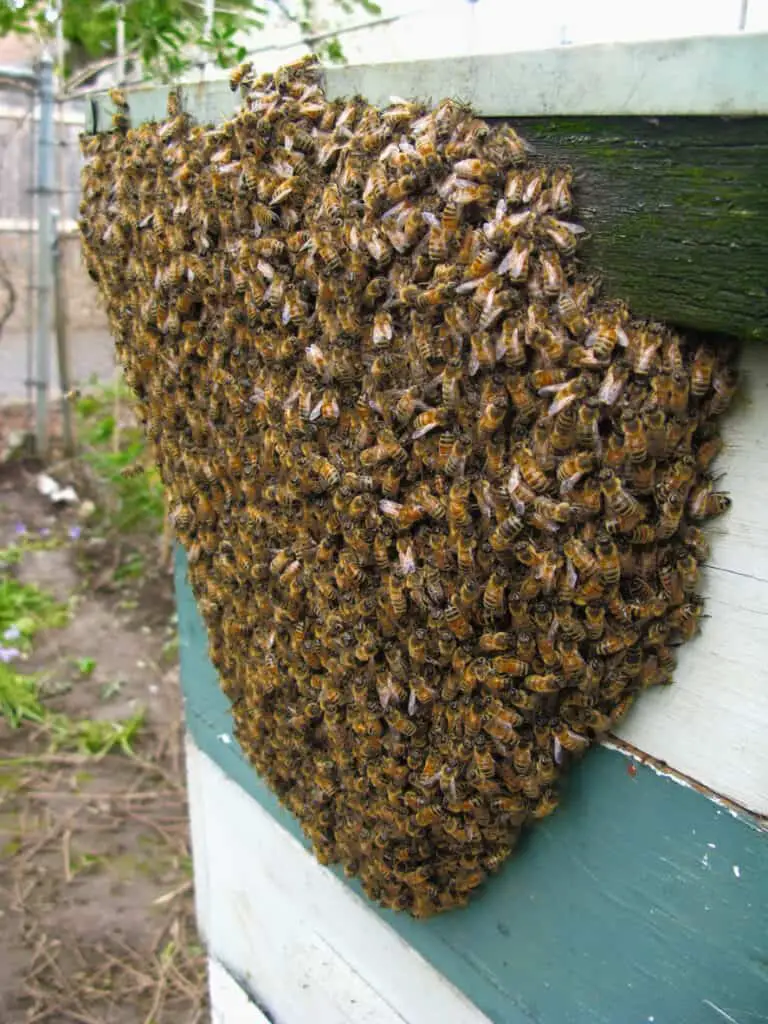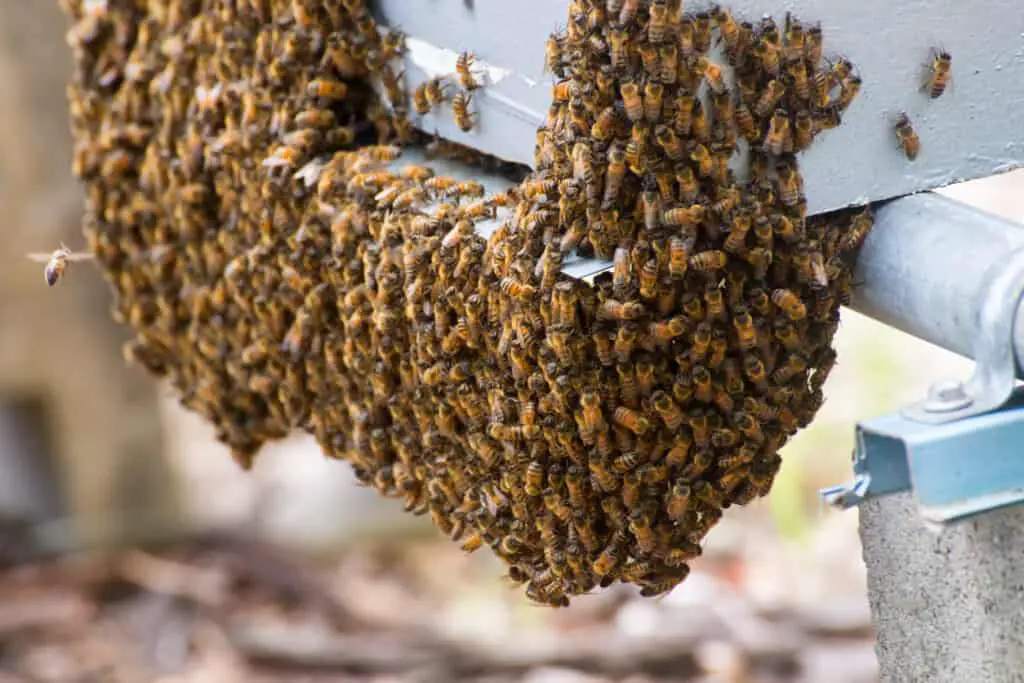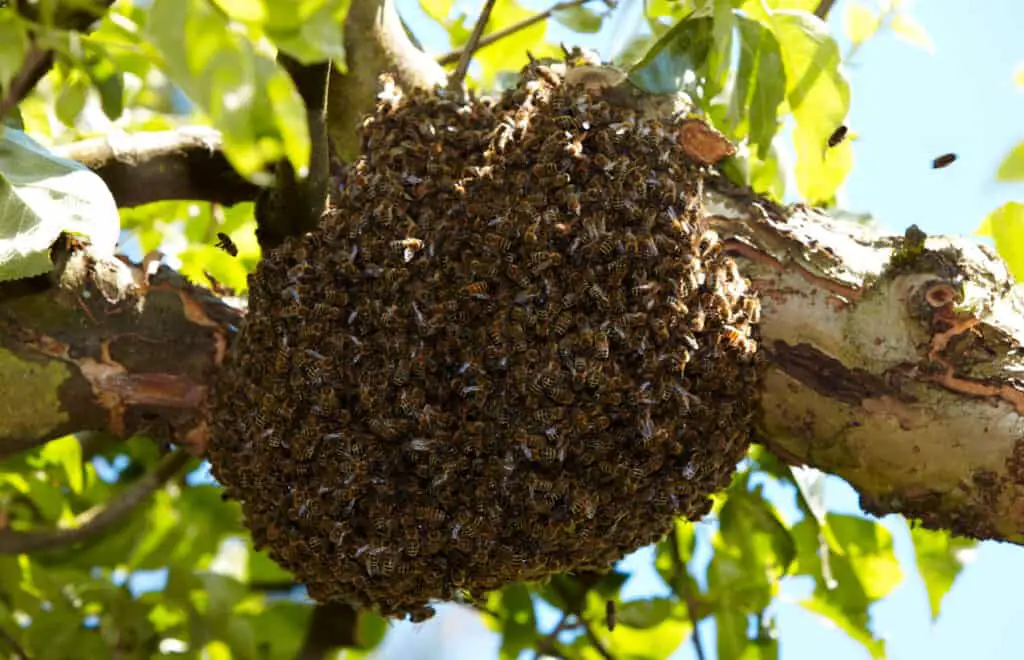Whether you’re a beekeeper or an admirer of bees, the truth remains that bees have an impressive record of living according to a unique structure that aids their colony’s survival. Bearding bees is one of these fascinating aspects that my beekeeping experiences have me privy to, and I’d like for us to explore those intricacies today.
Bee bearding occurs when bees group together in a V-shape on the exterior of a hive to keep cool during hot temperatures and create sufficient airflow to remove water evaporation in the nectar by fanning their wings simultaneously. It’s possible for bearding to last a few hours or a few days.
Bearding bees might be an impressive way to keep cool and cultivate nectar, but in truth, other factors also play into bearding bees’ behavior, such as a lack of pollen, nectar dearths, queenless hives, etc. Let’s explore these aspects further and deepen our understanding of bee-havior.
What Does It Mean When Bees Are Bearding?

When we work manual labor on a hot day, our bodies perspire to lower our body temperature, and we require a break lest we experience burnout. Bees, however, pursue their work relentlessly, preferring to confine themselves to one task and working without taking a pause, although they cannot perspire as we do, so they resolve themselves to bearding.
When bees beard, they group up on the exterior of the hive, form a V-shaped pattern, and fan their wings simultaneously to cool themselves.
This process is normal behavior for a colony of bees, regardless of the type of bees. It can provide valuable insights into the conditions of a colony, such as its strength, how successful it was with its harvest season, the stage of honey production they are current at, and early indicators of swarming if bearding happens frequently.
Why Do Bees Beard?
Since bees work without pause, it’s common for bees to beard in hot temperatures like 90 degrees Fahrenheit because their work has them generating a lot of heat while in the hive.
Apart from fanning their wings to create airflow, the outside air is typically much cooler and allows them to catch a cool breeze.
Furthermore, when the hive experiences a particularly lucrative honey season, bees will beard, fan their wings, and leave empty spaces in their formation that allow enough airflow for the collected honey to dehydrate. The airflow also helps evaporate traces of water in the nectar that prevents lingering micro-organisms, germs, and fungal contamination from surviving.
Since the honey “coffers” is full in a good season, bees wouldn’t be of much use in the hive, so they focus on cultivating the honey.
Until the temperature within the hive improves, the bees will remain outside. Depending on the conditions, bees may beard and leave the hive for as little as a few hours, extending all the way up to a few days.
Bearding is typical in the summer, especially during the warmest months. If your area is suffering a heatwave, you should anticipate your bees constantly bearding.
Remember that each hive is unique, based on its breed, overall health, colony age, and other factors. Every hive beards in its own way, so don’t be surprised if your bees take longer.
What Should You Do When Bees Beard?

When bees beard, let’s best to leave them to their own devices. Avoid trying to scoop them up and dump them back into the hive, spraying them with water or smoke, or disrupting the bearding process – it will only diminish the colony’s chances of survival.
If you try to chase them back into the hive, it will create a lack of airflow inside the hive that will affect the quality of the honey. Remember, airflow helps remove the excess water inside the nectar, preventing the growth of fungus and other harmful bacteria from developing in the nectar.
Furthermore, when there’s a robbing (when bees steal honey from a neighboring hive), your actions and presence can make the bees aggressive and ultimately dangerous.
Thus, bee bearding is an entirely normal part of the honey production process and serves as an essential tool for keeping cool to ensure the longevity of a bee colony.
It’s also essential that you provide enough room for a growing colony of bees. Bees will likely feel crunched or suffocated without enough room, leading to a potential swarm. It may include adding more supers on top of one another and ensuring sufficient ventilation for airflow but not too much that robbing can become a problem.
Bearding Bees Are Indicative Of Pollen Quality
Now that we know that bearding is part of the honey cultivation process, we can also say that an increased frequency of beards means that bees are collecting higher volumes of nectar due to the availability of pollen in the area. Some people opt for supplemental pollen substitutes to ensure a fruitful harvesting season.
Sunflower pollen, in particular, is an excellent resource for bees because it aids them in combating a parasite called Nosema.
Adult bees that fall victim to Nosema at an early age may experience digestive food problems for the remainder of their lives. These bees seldom generate royal jelly secretions, and they frequently forgo the brood raising stage of their lives instead of becoming forager bees at an early age. Consequently, these bees experience shorter lifespans.
When queen bees become diseased, they experience reduced lifespans and stop laying eggs. These effects negatively influence colony health, population, and performance, leading to an entire colony ending prematurely.
Don’t Confuse Bearding With Swarming
Bee swarming can look almost identical to bearding, but the reasons behind these behaviors are vastly different. While bearding helps keep bees cool and dehydrates their honey collection, swarming is essential to reproduction.
Swarming

When the condition of a bee colony is unfavorable, bees tend to become nervous and detach themselves by creating a swarm. Additionally, when the queen in a colony produces eggs sporadically or less frequently or doesn’t please the colony works or nurse bees, they will replace her with a new queen.
They accomplish this by building supersedure cells, queen cells constructed from the face of a brood comb. Now, while it’s true that we would consider this behavior rebellious, it counts as healthy reproductive behavior within a colony of bees. Nothing is wrong with bees swarming; according to the laws of nature, reproduction is indicative of a healthy animal or insect.
Although the bees would construct new queen cells with developing queens within the cells, they will not hatch until the old queens are no longer present. During this process, the nurse bees will also withhold some of her feed so that she can become more lightweight and able to fly. It allows bees to chase her around to stop her from laying more eggs.
Additionally, this behavior is typical when there are too many bees for a single hive, and they need to establish another hive. During this time, worker bees planning to leave with the old queen will gorge on the stored resources in the existing hive. It’s necessary to help them stay warm during freezing temperatures, plus they keep the queen warm and alive.
At the same time, the bees will send out scouts to look for suitable cavities to form a new hive. The additional resources they bring with them will help immensely in building a new comb. If the queen dies, they will continue sending out drones to search for an existing colony that they can assimilate with – this is how bees guarantee their existence.
How Do You Prevent Or Stop Swarming?
Having bee colonies swarm is not favorable because you lose half the workforce. When it happens during spring, you’ll most likely miss out on the summer honey flows because there aren’t enough worker bees to collect the abundance of nectar. Thus, keeping a large colony intact is favorable for the beekeeper and the colony, and here’s what you can do:
The Primary Reason Bees Swarm Is Due To Overcrowding
When you expand the size of the cavity of a beehive, you can prevent bees from swarming. Additionally, if the queen is young, she’s much less likely to swarm. As such, go ahead and place an additional super on top of the hive to give the bees enough space to fit a larger workforce.
An additional super will usually consist of around eight or nine new combs. When bees have something to do or a new goal to achieve, they’ll be much less likely to swarm and instead focus on filling the new combs with honey. In fact, it’s probably better to place a new super between the current ones because bees don’t need to travel as far to utilize it.
Removing Some Of The Brood Combs Reduce The Risk Of Swarming
If adding another super is not an option, you may also consider removing some of the brood combs – ensure that the queen is not on the queen excluder because you don’t want to separate her from the colony.
Removing brood combs helps to diminish congestion within the hive. Once removed, replacing them with empty frames will give the queen more room to lay eggs & give worker bees more space to collect honey. As a result, it will make the colony much less likely to swarm.
Can Bearding Bees Be Aggressive?
Bees are not usually aggressive unless they have a reason to protect something. In most cases, nectar dearth, the absence of a queen, robbing, alarm pheromones, rainy weather, and predators seeking honey or bees can alter the behavior of a hive.
Nectar Dearth
Nectar Dearth is something colonies of bees can experience when there’s not enough pollen to go around. Like how we can get cranky when we don’t get enough sleep or food, bees share a similar disposition when a shortage of flowers hinders the development of their hive.
As a result, honey bees will frequently visit blooms that they would otherwise shun; bumblebees may experiment with novel nutrients. You’ll also likely hear a loud buzzing noise right away because the hives have become more active, almost as if they’ve been disturbed. Many bees may be milling around the hive’s perimeter, simulating an oncoming swarm in some aspects.
Bees, too, will examine potential odors. They could look at your bee suit, hive gear, or even you, especially if you use fragrant products that contain nectar – such as barbeque sauce.
When a colony of bees is in danger due to a lack of resources, beekeepers can offer them a 50/50 mix of white sugar and water to give them an energy boost. This mixture provides them with the carbohydrates they need to fly and work to save their hive.
The mixture requires that you pour a drop or two of sugar water on a teaspoon or an upturned beverage cap in a covered area and allow the bees to drink it and recover. On the other hand, brown sugar is a bad idea since it is more difficult for bees to digest.
Robbing
When there’s a Nectar Dearth, bees will resort to robbing resources from neighboring colonies to bolster their own colony’s chances of survival. Neighboring bees will try to enter hives through side and back holes rather than through the front, where they must face fighter bees that aggressively guard against intruders.
Robber bees can severely limit the chance of survival of the target colony. They must first defeat the guard bees and any other colony members who may attempt to defend the supplies, although they risk their lives to steal the honey. As a result, it also puts a strain on their colony.
If there are no bees to protect the target colony because the colony perishes, the robber bees are still at risk of contracting a lethal illness or parasite and transferring it back to their own colonies.
It’s also due to robbing that beekeepers should avoid adding too many holes for ventilation purposes, as it can backfire and permit neighboring bee colonies a backdoor into an existing hive, causing its downfall.
Alarm Pheromones From Fighter Bees
When fights ensue, fighter bees release alarm pheromones that warn-off intruders and send friendly bees into a state of awareness and aggression. When bees die due to the fighting, the dead bees attract skunks, yellow jackets, hornets, and other predators, creating a snowball effect and making the bees more aggressive.
Queenless Hives
They are restless when colonies are unsatisfied with their current queen or do not have a queen because a new one is yet to hatch. Without something to work towards, they quickly become cranky.
After a queen bee dies, the worst-case situation is that the worker bees cannot raise a new queen. A colony without a queen will not be able to survive for long. The lack of a queen bee impacts worker bee behavior, causing them to become agitated or hostile. Worker bees may lay eggs, but they are all drones since they are infertile.
Since drones do not collect food or perform any labor, the number of productive bees decreases until the colony vanishes. The colony may become stressed, making it more prone to pests and illnesses. A beekeeper’s only option for rescuing a queenless colony is to transfer a new queen from outside the hive.
The colony is shocked when a queen bee dies unexpectedly, but it hurries to replace her. Workers usually identify eggs or larvae that are less than three days old and place them in specially built, vertically hanging “queen cells.” It takes, on average, three days for the fertilized eggs to hatch.
Rainy Weather
Rainy weather often introduces high levels of heat and humidity that can make bees feel like they’re fighting an uphill battle. Fanning their wings will do little to relieve the nectar of excess evaporation, and cooling off can be a challenging task.
Furthermore, they can fly in mild rain, but they prefer not to. The sun helps them navigate trees, grass, and flowers, especially during gloomy, rainy weather. Additionally, their wings might become wet in heavy rain, slowing them down. Large raindrops, in particular, are enough to shatter a bee’s wing and reduce the survival rate of the colony.
What Can You Do To Aid The Bee Bearding Process?
While you cannot directly aid a colony of bees in the bearding process, you can still make a couple of preparations to ensure that the process runs its course smoothly and without incident.
Provide Bees With Adequate Shade In Hot Temperatures
While sunlight can warm bees during colder temperatures and keep other insects like beetles away from the hive, providing shade can reduce bearding frequency and keep bees working for longer.
Indeed, beekeepers cannot always choose where to place a hive due to their locale, but colonies will undoubtedly have better protection from the hot, late afternoon sun when near shade, even though bees tend to do fine without it.
When bees become too hot without access to something that can help them stay cool, like shade, you may find that it will hinder nectar collection. In fact, house bees may go as far as to reject any new honey brought in by worker bees because they won’t be able to maintain it in an overheated hive.
Furthermore, when the hive becomes hot due to direct sunlight, even though the temperature itself is chilly, bees have a higher risk of not finding anything to forage. As a result, they will expend energy unnecessarily that could go toward developing the colony instead.
Adding More Supers Helps Hive Sustainability
When bees beard pretty often, it may indicate their hive space is too tiny, and they need more room for the colony to occupy – remember, when a large colony occupies a small space, it will make the hive very hot, leaving them little choice but to beard. If you believe this to be true after close inspection, consider adding supers to extend the hive space.
Having enough space is also essential so the queen can lay enough eggs and have the space required to store nectar for the coming winter.
Adding More Ventilation Will Reduce Bearding Frequency
During hot and humid weather, proper ventilation or insulation is essential. If you notice a lot of bee bearding, your tiny bees may be suffering from a lack of air. Make sure your top entry is open to hot and cool airflow.
Many beekeepers feel that utilizing a screened bottom board is the most effective approach to increasing their hive’s ventilation. A metal screen is helpful to create a screened bottom board, which generally includes an optional tray or sliding board beneath. They will assist push hot air out of the top of the hive by drawing cooler air from outside the hive.
Bees would naturally establish their hive in a tree trunk because it has good insulation capabilities and keeps most of the heat from the sun out. A tree trunk functions similarly to a basement in a home.
The solid walls and earth around a basement will assist in managing the temperature in the basement, preventing it from being excessively cold or too hot. A well-insulated beehive can function similarly to a tree trunk and a home’s basement. It’s worth debating whether or not you should entirely insulate a hive.
Like many things in life, keeping bees is about achieving the right balance. The most common problem caused by excessive ventilation is robbing. More ventilation implies more air circulating, which can attract robber bees by carrying the fragrance of honey and nectar.
What’s The Verdict On Bearding Bees?
Bearding bees are a natural and healthy part of a bee colony. It’s indicative of a healthy honey harvest with a lot of nearby nectar. Bearding keeps bees cool and ensures that honey remains free from bacteria and other unwanted foreign matter. Thus, let nature run its course and leave bearding bees so that they can continue on their grind.

